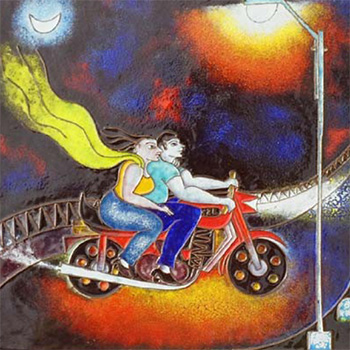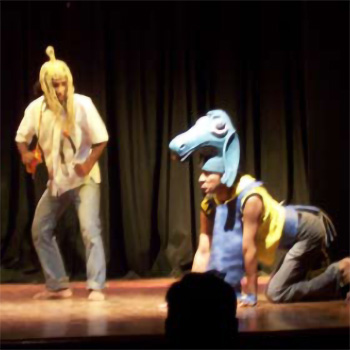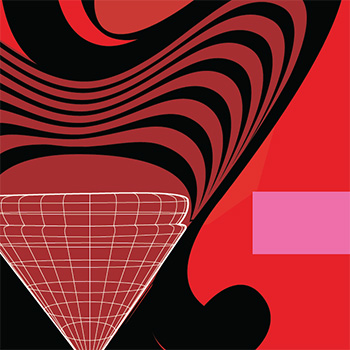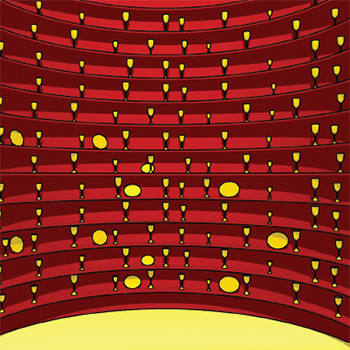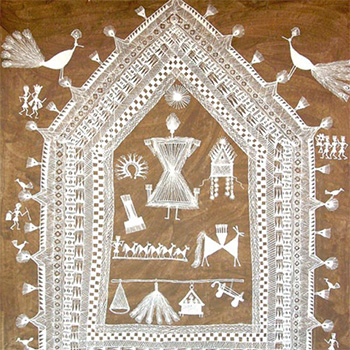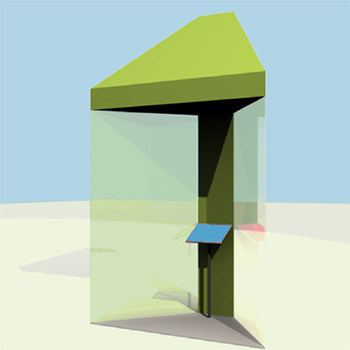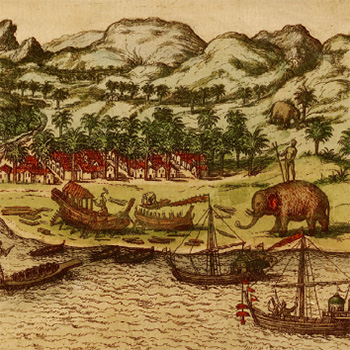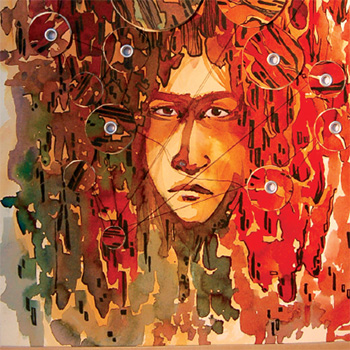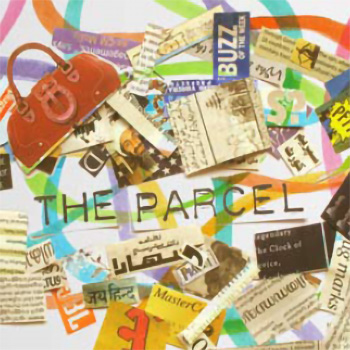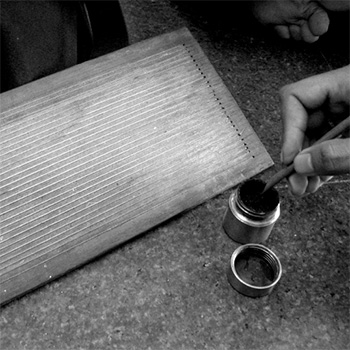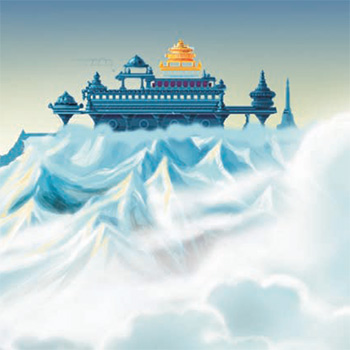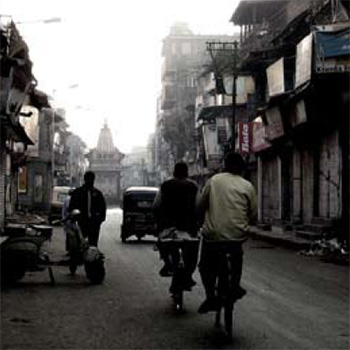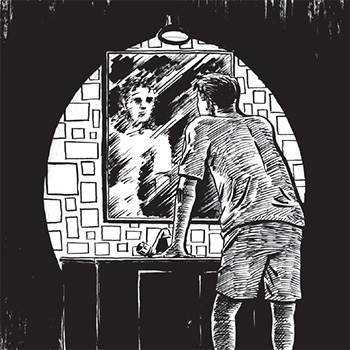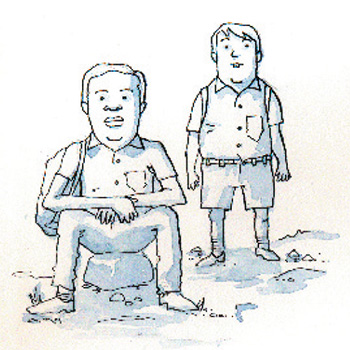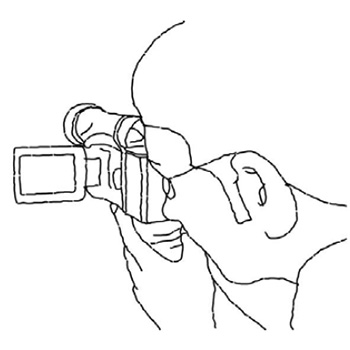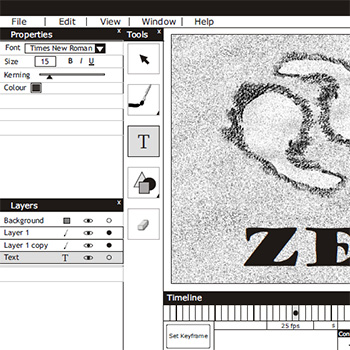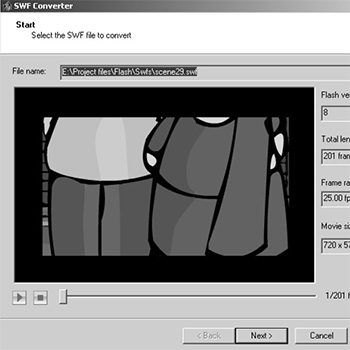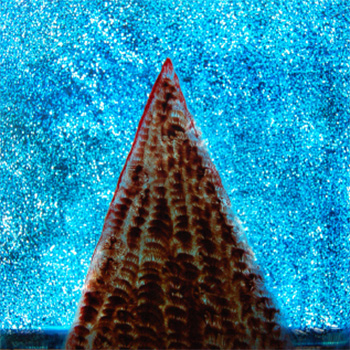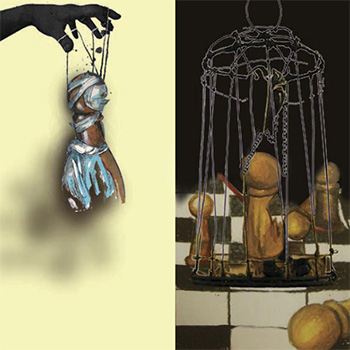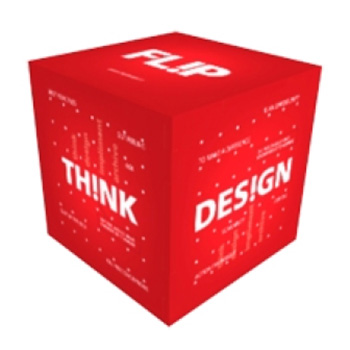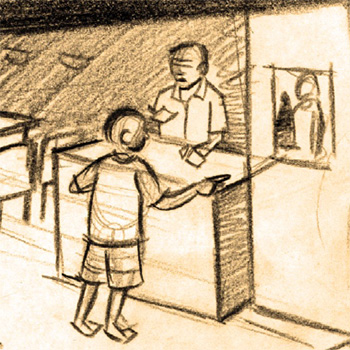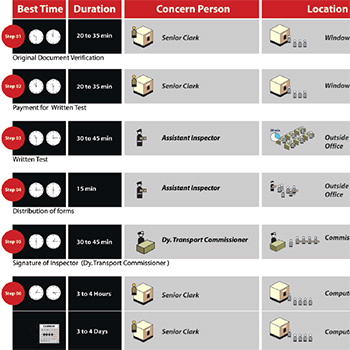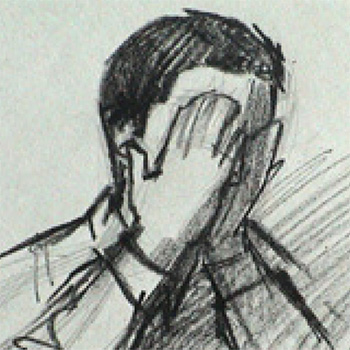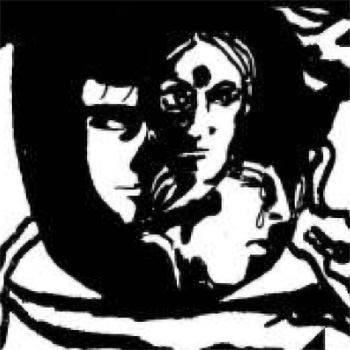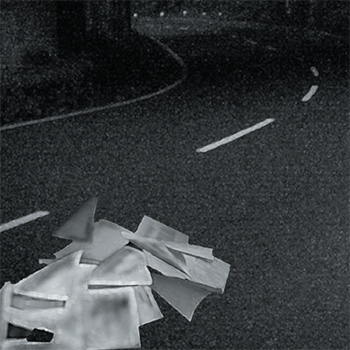Communication Design
Batch 2005-2007
(51 items)
Communication DesignBatch 2005-2007
(51 items)
(51 items)
Conversation with an Artist
by Aditi Babel
by Aditi Babel
“Conversation with an ”artist’”—the project was essentially focused on understanding the approach of an artist so as to understand the uniqueness in his thinking process and his creations. This project gave an opportunity to study what we understand by the term culture and acknowledge its importance as an inspiration for any creation. My keen interest was to find out how culture is understood by different people and what makes it easier for them to express their creation in terms of culture as an inspiration and sometimes as a tool and also sometimes just unknowingly creating something that defines culture itself.
Details >>Abhinaya- System of Dramaturgy
by Aditi Babel
by Aditi Babel
Theatre - Abhinaya, the ancient Indian system of dramaturgy. This performing art of theatre, as the dictionary defines, ”the activity or a profession of acting, producing, directing, or writing plays,” is an art form that has a beautiful pattern of planned design of actions. It's a form of extensive teamworkin which the efforts of each and every member of the production matter a lot for the success of the play, the irony of the situation being that every action of every person who is part of the production is mainly governed by the director of the play. The entire system depends on the directors play of actions. This art form includes the most important and basic elements of design, i.e., lines, planes, textures, colours, space, shapes, and forms.
Details >>Theatre xpression illusion
by Aditi Babel
by Aditi Babel
Theatre - Abhinaya, the ancient Indian system of dramaturgy. As the dictionary defines the activity or a profession of acting, producing, directing, or writing plays,” it has a pattern of planned design of actions. Theatre is a medium that encloses within itself all forms of performing arts; it can evolve itself with forms like drama, action, speech, dance, poetry, etc., and also encourages experiments and exploration in one and all. It is one of the most effective forms of communication, as in a very interesting manner it holds the attention of its viewers and communicates the message across.
Details >>Game Design on Indian Temples
by Aditi Babel
by Aditi Babel
The project focuses on designing a game based on the elements of Indian temples. The motivation to take up this project was to study an aspect of Indian tradition and culture, a very significant part of which are the Indian temples. This project gave me a chance to understand important and different elements related to Indian culture. The initial objective was to create interest in the subject that encourages self-involvement and motivation to learn more on the subject. The structural and strategical approach of game designing was ideal to create awareness on the subject with a lot of interest, i.e., the rituals, beliefs, myths, and significances attached to them, which are being forgotten with time. Games have been an intimate part of Indian tradition and culture. Some of the most famous and interesting games were developed and played here and became a part of the tradition, e.g., Pachisi.
Details >>An Enquiry into the Absurd- The Fictions of Jorge Luis Borges
by Anand Prahlad
by Anand Prahlad
This project delves into the surreal and labyrinthine worlds crafted by Jorge Luis Borges, interrogating notions of reality, fiction, and absurdity through visual and narrative explorations. Employing techniques of communication design, it interprets Borges’s themes—infinite libraries, mirrors, paradoxes, and alternate worlds—in a graphic and conceptual medium, offering viewers a contemplative journey that blurs the line between the real and the imagined. The work is reflective of Borges’s playful tension between order and chaos, inviting audiences to question the nature of meaning, identity, and perception.
Details >>Icons : The Lotus
by Anand Prahlad
by Anand Prahlad
My internship at RGD lasted a month, starting early May 2006. During this period I had the opportunity to work on three live projects. I also researched and studied the origin and development of the lotus as an international icon. The Lotus—Of the many icons that represent Eastern civilisation, the lotus is probably amongst the most famous ones. This study traced the origin of the lotus as a symbol of divinity and spirituality all around the world. The information was gathered from books and other online resources, which was assimilated with illustrations drawn by me in a single book.
Details >>An animation on- The city of mumbai
by Anand Prahlad
by Anand Prahlad
The objective of this project was to go through the process of creating an animation using a blend of 3D animation and 2D techniques. The film, approximately 5 minutes and 18 seconds long, was created using a blend of conventional 3D modelling and animation and pixilation (stop-motion animation using human actors). The theme for the animation is the city of Mumbai. The story more specifically looks at how the rain affects people in the city. The premise for the story is set in a six-floor, seemingly improbable building, where the inhabitant of each floor deals with the excessive rain.
Details >>An animated study of a psyche
by Anand Prahlad
by Anand Prahlad
The objective of this project was to create a film with characters whose foundations lie in some of Jung’s theories. Since my project from the previous semester looked at a broader scenario of the rains in the city and how the inhabitants of a hypothetical building deal with the deluge, this semester’s project deals with a more personal and quiet self-space. The story outlines the confusion and turmoil people go through during the transitional periods of their lives. The film is rendered using a toon shader. The end effect is that of a hand-drawn and inked illustration.
Details >>Journey of an Artist- A book about my father Maruti Patil
by Barkha Patil
by Barkha Patil
This project is a deeply personal design narrative and publication endeavor by Barkha Patil, which artistically chronicles the life, ethos, and creative legacy of her father, Maruti Patil. Framed as a book, it weaves together visual storytelling, archival memories, and design sensibility to reflect both familial bonds and artistic identity. Using the medium of communication design, the work becomes a tribute and an inquiry—not just into a life lived, but into how memory, biography, and aesthetic expression combine to shape one’s legacy.
Details >>Warli Painting- Investigation into Non Textual Interface
by Dipu George
by Dipu George
There are several clans of Adivasis (original inhabitants) occupying part of the region north of Mumbai, the most numerous being the Warlis, who call themselves kings of the jungle. The Warli Tribe, which resides in the Thane district of Maharashtra, is spread out mainly in the villages of Dahanu, Talasari, Mokhada, Vada, and Palghara. For our study we chose the village of Dahanu. The origin of the Warlis is yet unknown, and no records of their art form are found, but many scholars and folklorists believe that it can be traced to as early as the tenth century A.D., when such men learnt to build walls of the house. The economy of the Warlis is basically agrarian. The Warlis have survived for millennia in harmony with their environment and without oppressing others. Their culture incorporates the spiritual and material, living and non-living, into one integral whole.
Details >>Summer Training at Forest Design
by Dipu George
by Dipu George
The client is a major stock photo agency. The project involved redesigning the interface icons in their image management software. The objective was to streamline the workflow to increase the efficiency. This software has basic image editing tools and is primarily used for categorising and keywording images. My role in this project was to redesign the current set of icons and render them with a new visual look as well as create new icons with consistency and bring out a new contemporary style to the set.
Details >>Interactive Campus Information System for IIT Bombay
by Dipu George
by Dipu George
This project is an attempt to address (learn the process involved in) the designer’s challenge to make information accessible and available to users within the campus. This project attempts to create an interactive information system that would make it easy to access the information the user needs from the complex set of information in IIT Bombay. The interactive system seeks to reduce the cognitive load on the user and minimise the learning time otherwise normally spent to access such a system. The system is proposed to be accessed by users within the campus. Interactive systems tend to aid the user in navigating and zooming into specific areas. The report structure comprises the requirement study, where the user needs were identified, followed by the data collection and the conclusion of the analysis. The interface design and navigation aim to provide the user with an effective interface so he/she could access information more easily. The proposed system is a simulated model and demonstrates its effectiveness. The working model can be fulfilled after all data has been fed into the system.
Details >>Information Maps of Kerala
by Dipu George
by Dipu George
The scope of the project is to present a tapestry of Kerala’s history from the earliest times to AD 1850, covering aspects like history, culture, and geography in an interactive visual timeline. The interactivity of digital media makes it possible to represent such interesting information compared to that of print media. This project seeks to design an interactive information map (a visual timeline) that would highlight interesting snippets of information from Kerala’s history. The interactive visual map seeks to present to the user an interesting experience of the diverse aspects of Kerala in the historical perspective.
Details >>Faces as a narrative
by Fatema Kainan Barot
by Fatema Kainan Barot
Being born and brought up in different places, in different contexts, interactions with other people and experiences of different circumstances consciously or subconsciously have made people what they are or what they have chosen to be. There are various factors that keep influencing people’s identities and personalities. Respective identities are reflected through various manifestations like their posture, body language, clothing, mannerisms, behaviour, gestures or their expressions or faces. There are stories about themselves that they reveal. Images of themselves that they create or those that are created on their own. However, they are revealed within the scope of the readability of the observer. The observer too has developed this sensitivity based on his own contexts, experiences and associations he has established through his own understanding of events, circumstances and other people. It is the perception of these identities or stories through faces that is intended to be studied through this project. The route to it is also through my perception of identities and how I read people through their faces.
Details >>Animation on Media Revolution
by Fatema Kainan Barot
by Fatema Kainan Barot
Communication media enables the sharing of information in the form of data, images, ideas, etc. We rely heavily on media for having access to any information, as it is not in anyone’s capacity to have authority or knowledge of all the information that is available through various sources. Hence, being the source of our awareness of many things, it plays an important role in moulding our mindsets and opinions of many things. Dominant forms of media dictate aesthetic preferences and forms of social, political and economic structuring in society, as they have a collective influence on a mass audience. It plays a major role in the establishment of perceptions in the minds and imaginations of entire societies as it advocates the development of constructive or destructive ideas towards various issues at different levels in a social system, like family, violence, relationships, authorities, identities, etc.
Details >>Conversations through Calligraphy
by Fatema Kainan Barot
by Fatema Kainan Barot
“Conversations through Calligraphy” is a communication design project that investigates the expressive potentials of calligraphic forms as a medium for dialogue and meaning. Led by Fatema Kainan Barot (2005–07 batch at IDC), the work explores how visual letterforms and compositions can become carriers of metaphor, emotion, and conceptual exchange beyond their linguistic content. Under the guidance of Prof. G. V. Sreekumar, the project experiments with integrating calligraphy into conversational contexts, blurring the boundary between language and visual art to invite viewers into a reflective, mediated interaction.
Details >>The Face as a Narrative
by Geetanjali Srivastava
by Geetanjali Srivastava
For every object that we see around us or voice we hear on the telephone/radio, we as simple people desire to form a face or give it a facial identity. We look for faces in everything, which always consist of two symmetrical horizontally positioned dots for the eyes and a horizontal line just a little below to form the mouth. All other details are negligible; it is not vital that other details like the forehead/eyebrows/nose/philtrum and chin be present. The face is an important feature for the identification of others and conveys significant social information. The basic face would be shaped of eyes that can see us and a mouth that may speak to us. As children, we may construct faces out of plug points and headlights on cars/scooters, draw smileys on dusty car windows and make faces at the mirror. The face is the only immediate and widely recognisable feature which distinguishes one individual from another. Ironically, because of the importance of its role in social interaction, the newer communication systems like SMS and online chat completely eliminate the instance of ‘seeing’ the person you are communicating with. There are solutions, of course, to this situation; one of them is where you can post a picture of yourself, or if you do not like your face too much or simply want to ‘lie’ about your appearance, wear a mask!
Details >>Falling Leave- An Interactive Learning Kit
by Geetanjali Srivastava
by Geetanjali Srivastava
Learning in schools is practised in a way where students are ‘told’ information about various topics through textbooks which they are expected to memorise and finally repeat during assessments. The chapters in textbooks are arranged in increasing order of complexity, at the end of which there are questions which the student is expected to answer by searching through the content in as many attempts as necessary. Students begin to understand that grading is on the basis of accuracy of recalling the information, and hence, learning to copy-paste answers is the type of learning that students pick up as a habit. Merely remembering words like ‘sunrise’, ‘rain’, and ‘sea’ does not mean that the student has understood the meaning of the word. He needs to experience the sunrise, see the darkness recede and the light take over, walk on the beaches to experience the water and sand, and get wet in the rain to enjoy and understand the proper meaning of the observable fact.
Details >>Falling Leave- An Interactive Learning Kit
by Geetanjali Srivastava
by Geetanjali Srivastava
Learning in schools is practised in a way where students are ‘told’ information about various topics through textbooks which they are expected to memorise and finally repeat during assessments. The chapters in textbooks are arranged in increasing order of complexity, at the end of which there are questions which the student is expected to answer by searching through the content in as many attempts as necessary. Students begin to understand that grading is on the basis of accuracy of recalling the information, and hence, learning to copy-paste answers is the type of learning that students pick up as a habit. Merely remembering words like ‘sunrise’, ‘rain’, and ‘sea’ does not mean that the student has understood the meaning of the word. He needs to experience the sunrise, see the darkness recede and the light take over, walk on the beaches to experience the water and sand, and get wet in the rain to enjoy and understand the proper meaning of the observable fact.
Details >>Newspaper Redesign- The Free Press Journal
by Geetanjali Srivastava
by Geetanjali Srivastava
“Newspaper Redesign—The Free Press Journal” is a communication design project that reimagines the visual and editorial layout of a daily newspaper to improve readability, coherence, and aesthetic appeal. Undertaken by Geetanjali Srivastava as a P3 project at IDC IIT Bombay under Prof. G. V. Sreekumar, the work involves rethinking typographic hierarchy, information architecture, and visual flow to bring freshness while retaining journalistic integrity. The redesign strives to balance the demands of content richness, clarity, and user engagement in the evolving media landscape.
Details >>Study of tools and innovative Techniques of calligraphy
by Harshvardhan Kadam
by Harshvardhan Kadam
Calligraphy since ages has been evolving from its original form. So have its functions. But the basic requirements of calligraphy have always remained there and are mutually dependent. Calligraphy is incomplete without these essentials, i.e., the tool, the medium and the surface. Calligraphy since ancient times has remained as a medium of visual communication, communicates a message(s) for the sake of wisdom, and has not widened much. But there have been a lot of experiments, reformations, and cross-cultural adaptations over the scripts of calligraphy, like writing the Devanagari script with a Japanese round brush, modifying steel tools to be ergonomic for Devanagari, installing a reservoir for ink in the tool itself, etc., which have contributed to shaping a new dimension of calligraphy. The process of evolution of letter forms has deep spiritual roots. Akshar is an experience of a very highly profound meditation process. Calligraphy can be called a process in which your mind and body are involved towards attaining a simple goal, of akshar. Akshar means the one that will remain forever.
Details >>Indrasmriti- Remembering Indra
by Harshvardhan Kadam
by Harshvardhan Kadam
Indra Smruti is a small attempt towards remembering the most respected god from the Rigveda, who is no longer worshipped as a god, nor does there exist a temple of him. The title speaks all about the project – remembering Indra once again in today's era. The idea originated as an opportunity for visualising the dynasty of Indra. But as time travelled, more and more mysteries about the Vedic and the Hindu Sanskriti were revealed. The thought of Indra was no longer an idea. It took a shape of its own. It started evolving and revealing itself. Of course, the method which I followed made it possible. This evolving and revealing process is never ending. As we can see numerous icons of Vishnu, Shiva, Ganesha, and Ram, and just by looking at them, we can state the icon. We tend to understand the character and recognise them. But Indra's character/icon is not so visible through Hindu iconography. This project is about exploring Indra the way I have perceived and absorbed her. I did not want my expressions to be very stereotyped comic style. The initial explorations were very much like the conventional comics style, but later on I tried exploring in my personal style, though the style was not an issue. The later explorations were more expressive. I tried to draw a line between comics' style and the miniature paintings.
Details >>Indrasmriti- Remembering Indra
by Harshvardhan Kadam
by Harshvardhan Kadam
Indra Smruti is a small attempt towards remembering the most respected god from the Rigveda, who is no longer worshipped as a god, nor does there exist a temple of him. The title speaks all about the project – remembering Indra once again in today's era. The idea originated as an opportunity for visualising the dynasty of Indra. But as time travelled, more and more mysteries about the Vedic and the Hindu Sanskriti were revealed. The thought of Indra was no longer an idea. It took a shape of its own. It started evolving and revealing itself. Of course, the method which I followed made it possible. This evolving and revealing process is never ending. As we can see numerous icons of Vishnu, Shiva, Ganesha, and Ram, and just by looking at them, we can state the icon. We tend to understand the character and recognise them. But Indra's character/icon is not so visible through Hindu iconography. This project is about exploring Indra the way I have perceived and absorbed her. I did not want my expressions to be very stereotyped comic style. The initial explorations were very much like the conventional comics style, but later on I tried exploring in my personal style, though the style was not an issue. The later explorations were more expressive. I tried to draw a line between comics' style and the miniature paintings.
Details >>Knowing- Pune A Documentary Film
by Harshvardhan Kadam
by Harshvardhan Kadam
A strong attachment with the city is one reason that I thought of documenting the stories and events that have transformed the city. It is a common feeling that usually a class of people have for their city they have grown up in. Being a Puneite, I had not known a lot of interesting things about Pune, like how the city got its name. There were similar scenarios around me, due to which I thought of understanding the evolution of the place. The story which I want to tell could be about some simple events, treaties, wars, floods, rivers, mansions, roads, kings, ministers, architecture, etc. My idea was to talk about the unknown facts, myths and stories of the city, but after questioning the idea of unknowingly, one gets an answer that whatever one hears or reads, the next moment it becomes known. So the goal became making a video on relatively unknown facts of Pune.
Details >>Story-telling in Graphic Novels- A Study of Autobiographical Graphic Novels
by Hemant Kumar
by Hemant Kumar
‘Graphic novel’ is a term generally applied to refer to comic books which are aimed at a mature audience and are centred around mature and complex themes. Graphic novels are supposed to have better artwork and printing and binding. They can be published as original single-volume novels or compilations of previously published multiple-volume serialised stories. A collection of short stories (in comics) is also referred to as a graphic novel. Although a widely used term now, ‘graphic novel’ is more of a publisher’s and marketing term. As comics are generally associated with juvenile themes and adolescent readers, the term graphic novel indicates a departure from monthly disposable magazines to a permanent bookshelf collection. However, many of the foremost authors, like Alan Moore, say that they are fine with the term ‘comics’ and do not intend to be called graphic novelists. Acclaimed comics theorist Scott McCloud also remarks that a square binding and slick printing do not guarantee a creditable work of literature and that comics as an art form and a communication medium do not need the term graphic novel to prove their worth.
Details >>Grandmother India
by Hemant Kumar
by Hemant Kumar
Grandmother India is a Mumbai-based firm providing visual communication services to a variety of clientele spanning from music labels, fashion brands, hospitality agencies and IT giants to independent artists, photographers and filmmakers. Set up in 1999 by Kurnal Rawat and Tejas Mangeshkar, the firm believes in local designs with global aesthetics and is known for creating a unique visual milieu. During my time at Grandmother India, I got involved with various design activities differing in nature, intention, medium and complexity. Taking up tasks and responsibilities offered a great deal of learning.
Details >>Comics On Violence
by Hemant Kumar
by Hemant Kumar
This project is aimed towards addressing the issue of violence that is changing many lives voluntarily or involuntarily. It is an attempt to understand the concerns and effects of violence and communicate the same through a medium often criticised for glorifying it: comics (defined by Scott McCloud as juxtaposed pictorial and other images in deliberate sequence, intended to convey information and/or to produce an aesthetic response in the viewer”). Despite the great potential that the medium of comics offers in communicating ideas and storytelling, its application has been quite limited in popular culture. Comics have been criticised for promoting and selling violent content to kids. Still, there is a lot more to comics than popular culture. The project seeks to provide a view of the notions of violence and its existence in a society through exploring the medium of comics. Through the project I aim to build an outlook of things as they are and as they should be in a world so restless and impatient to resort to violence for all that is unfair and unjust.
Details >>Stories of Failure
by Hemant Kumar
by Hemant Kumar
This project is aimed towards addressing the issue of violence that is changing many lives voluntarily or involuntarily. It is an attempt to understand the concerns and effects of violence and communicate the same through a medium often criticised for glorifying it: comics (defined by Scott McCloud as juxtaposed pictorial and other images in deliberate sequence, intended to convey information and/or to produce an aesthetic response in the viewer”). Despite the great potential that the medium of comics offers in communicating ideas and storytelling, its application has been quite limited in popular culture. Comics have been criticised for promoting and selling violent content to kids. Still, there is a lot more to comics than popular culture. The project seeks to provide a view of the notions of violence and its existence in a society through exploring the medium of comics. Through the project I aim to build an outlook of things as they are and as they should be in a world so restless and impatient to resort to violence for all that is unfair and unjust.
Details >>Documentation of Animation Techniques
by Nair Vineeth Anand
by Nair Vineeth Anand
The project Documentation of Animation Techniques is a special communication design endeavour that meticulously explores, records, and analyzes various methods and practices in animation. Under the supervision of Prof. Shilpa Ranade, the work seeks to demystify and make explicit the often tacit skills behind motion, timing, and visual storytelling. Through this documentation, the project not only preserves techniques but also acts as a pedagogical bridge, helping designers, animators, and students navigate the principles and craft of animation in a structured, accessible way.
Details >>White Light Moving Picture Company P.Ltd.
by Nair Vineeth Anand
by Nair Vineeth Anand
White Light Moving Picture Company Private Limited was incorporated on 4th May, 1987, as a private limited company. The registered office and its head office are in Kolkata, West Bengal. Its business operations are carried out from its Mumbai branch office situated in Famous Studios in Mahalaxmi. The company’s Chairperson and Managing Director, Ms Namita Roy Ghose, and its Director, Mr Subir Chatterjee, are both based in Mumbai. They are also the co-directors of all commercials produced by White Light. The Finance Director, Mr Ujjal Ghosh, is based in the Head Office at Kolkata. The company engages around fifteen more personnel to undertake the key activities relating to film production, administration and business development.
Details >>Design of a software tool for animators
by Nair Vineeth Anand
by Nair Vineeth Anand
Experimental animation is like a bottomless chasm. The possibilities are endless. The key being, anything & everything can be animated. Under the guidance of Prof. Ravi Poovaiah, the basic idea of providing a platform for exploring possibilities took shape. A variety of styles & diverse use of the medium have always been the key focus in experimental animation. Reaping the power of technology and combining it with an in-depth thought process laid the base. Artificial intelligence to help the software think & comprehend was another focus point. The challenge was being able to provide a variety of styles and to embed a sense of creative freedom for aspirants wanting to get a glimpse into the world of experimental animation. Planes or surfaces to play with were looked at so as to generate interest amongst the users. To be able to control plane parameters and thereby moderate the behaviours of the plane added to the vision. This software concept provides for smart functioning. The motive being to showcase the possibilities in plane-moderated experiments and provide for it. The interface aids in creating various animations using water, sand, a light grid or paper as the surface.
Details >>Load Shedding- An Animated Short
by Nair Vineeth Anand
by Nair Vineeth Anand
The newspapers lately are abuzz with the growing power cuts in the suburbs. My project deals with the same, but in a subtle and light manner. With a bit of humour, and through a simple story, I have attempted to spread the awareness to curb load shedding. The story has a central character, the “load shedding baby”, who in his simple, sweet way manages to slay the “load shedding monster”, which has been haunting the city of Kalyan for a long time. The focus has also been laid on the fact that frequent power cuts have seeped into the lives of the people, and they have taken it as a part of their lives. Protests are staged, and the electricity board is bad-mouthed. But these are not that which will help us get rid of this syndrome. It is only when we start thinking and start saving electricity in our homes that we can make a difference. I have tried to bring out this message through my animated short.
Details >>Understanding sexual morality- An animation short
by Poonam Madhav Athalye
by Poonam Madhav Athalye
I wrote a script as it came to me. Once I was thinking of a dear friend of mine. We were best of friends when we were kids, but as time passed by, we went different ways. I was not in touch with her for a long time. Later when I heard of her, she was known to people as an easy woman. Someone known for swindling men around. I was very disturbed and felt really bad. I tried to justify her side unknowingly to our common friends, but I could not. I was angry with her, but I never showed it. I wanted to scold her, but I thought I could not. It took us five years to develop affection for each other again. And it took me even longer to realise that she did not do anything ‘wrong’. Neither was she right. There is nothing that is right or wrong sometimes. I think no one is in a place to judge if somebody has been ‘morally’ right or wrong. Because if one tries to see from the involved person’s point of view, it is circumstances and time which together can lead you on a path, which can neither be right nor wrong. It can only be different from your path. There are several kinds of sins which are morally put forth, but I decided to contemplate on the sin of lust. These are matters which involve intimacy. I certainly don’t advocate betrayal or cheating, but I feel the sexual parameters change depending on the person. I feel there should not be ground rules for morality which are applicable to everyone.
Details >>Recreating the experience of a dream ‘Cotton dreams’ an animation
by Poonam Madhav Athalye
by Poonam Madhav Athalye
During a typical life span, a human spends a total of about six years dreaming, which is about 2 hours each night. It is unknown where in the brain dreams originate, if there is such a single location, or why dreams occur at all. “I had a horrible nightmare that there were sick kittens all around me, hungry and sick. One of them, a small black kitten, jumped up on my lap, and to my horror, split in half, and the top half jumped off my lap, leaving the bottom half. I screamed and woke up.” Dreams are expressed in the form of sensory metaphors. Some say that dreams are metaphorical translations of waking expectations. From the point of view of the dreaming state of mind, dreams are real events in real environments. Based on this notion, one can re-enter the landscape of a dream and flash back to the images, whether it is a memory from waking life or from dreaming. One enters a hypnagogic state; then, through the process of questioning, images are explored through the perspective of feelings and sensations manifested in the body, enabling new awareness to develop.
Details >>Storytelling in the Graphic Novel- Analysis into the process of developing the novel
by Prarthana Hariharan
by Prarthana Hariharan
The intention of this project is to gain a clearer understanding of the process involved in the generation of a graphic novel, the seamless integration of the text with the imagery. It delves into the manner of representation of serious and politically tense topics through this medium. The nature of political and historical novels is studied through selected pieces of work. The process involved in the translation of a film into a graphic novel also falls within the spectrum of my study.
Details >>J. Walter Thompsons
by Prarthana Hariharan
by Prarthana Hariharan
J. Walter Thompson is a worldwide organisation. It is one of the oldest advertising agencies in the world. They over the years have built an enormous network of companies across all continents. Now they are a company with a network of over 200 regions. The infrastructure of this company has been built over years of dedication and solidarity. Recently the company went through a major change. The change in the colours of JWT and the compression of the name of the agency from J. Walter Thompson to JWT has been one of the colossal tasks that have been taken up. For a 75-year-old company to undergo such a huge change was considered to be a big move. They have one of the largest ranges of clientele. Their client list ranges through numerous products in the market. They have some of the most prestigious sets of clients.
Details >>Visual Representations of the work of Omar Khayyam
by Prarthana Hariharan
by Prarthana Hariharan
Imagery and representations of the poems that run alongside Khayyam’s words. Explorations in terms of mode of visual imagery, content, medium, calligraphy and typography. Calligraphy and typography that is driven by the content of his poetry. This will act as a visual compilation of Khayyam’s poetry.
Details >>Photo Exploration- Faith and Penance of the Tamil folk- A book on the belief and worship patterns
by Prarthana Hariharan
by Prarthana Hariharan
This project documents the faith, rituals, and penance practices of the Thevar and Nadar communities of Tamil Nadu, primarily from the southern districts of Ramanathapuram, Virudhunagar, and Madurai—collectively known as the Thevar belt. Through visits to various Mariamman temples in Chennai and the grand Thiruvizha at Samayapuram in Trichy, the study captures the deep-rooted traditions, devotion, and spiritual intensity of the participants. The photographs reflect the atmosphere of worship and offer a glimpse into the enduring power of faith that continues to shape Tamil cultural and religious life.
Details >>Warli Painting- Investigation into Non Textual Interface
by Prashant Bhandare
by Prashant Bhandare
Interfaces that deal with aspects other than text can be termed as non-textual interfaces. Audio, video, spoken language, performing arts, visuals, etc. are some examples of non-textual interfaces. Some of the examples identified from the non-computing environment were Warli paintings (narratives), Kathakali (gestures and audio), Dabba walas code signs (signs and symbols) and temple motifs (symbols). Because of time constraints the scope of the project was restricted to analysing only one from the above-mentioned.
Details >>Summer Training at ~ FL!P Design, Bangalore
by Prashant Bhandare
by Prashant Bhandare
As part of the M.Des. (visual communication) course, students have to undergo a month’s industry training at the end of the second semester. This one month has a lot stored in it, as there is interaction with the company and people working there, getting involved in projects, helping out, sitting in brainstorming sessions and loads of fun.
Details >>Hapus ka simple joy- A Story on Child Labour
by Prashant Bhandare
by Prashant Bhandare
In our everyday life we came across many social problems around us. “Child labour” is one of the problems in the list. The worst thing about this problem is that the victims are the tiny juvenile humans. They are children, as delicate as flowers, but are scrambled underfoot by conditions. Conditions could be anything, but the fact is that they have lost their childhood. This is the time when a child needs a lot of love, protection, education, good food, etc., so that they will develop in all aspects. From this project I have tried to portray a simple aspiration of a particular child labourer (Bhoora) who works in hazardous conditions. And how he struggles to fulfil a small desire.
Details >>Information graphic for public place- Regional Transport Office, Thane
by Prashant Bhandare
by Prashant Bhandare
The need of the society in the government sector is to understand complex processes and eliminate the third-party involvement to reduce the corruption and also reduce the time and stress involved in completing the task. This is taken as the aim of this project to analyse the possibilities of exploration. In India many government sectors have various kinds of complex processes which need to be followed to complete the task for the people. In this project I decided to explore the possibility in R.T.O. (Regional Transport Office), where a huge number of people’s interactions happen every day. From the 18-year-old student to the 40-year-old private vehicle owner, they need to face many complex processes. Processes are not easy to understand when they are on paper. The understanding of processes very effectively and easily is taken for the exploration.
Details >>Contemporary Indian Short Stories
by Russell Gonsalves
by Russell Gonsalves
Stories are told, heard, seen, and read, but most of all… felt. A good story has the uncanny ability to enrapture from the oldest to the young. Combining subject, experience and message, each writer has taken an everyday theme and built around it a brief yet captivating drama – an essentially human requirement. But beyond the story itself, a short story can serve as a valuable and intimate account of a chosen subject, a place, an incident, or a person. Without the employment of pigment or bristle, a short story can at once paint a beautiful picture, unbound by time. And like painters, every author seeks to capture a different subject. From the value of the love of a family to the use of a dining table, the stories are based on themes as eclectic as the people in this nation. However, if there is one thread holding them together, it is the feeling of every author's own personal experience that comes through in a rather compelling manner. In 'The Fig Tree Stands Witness', the author tells of a tragically materialistic world through the hardships faced by his uncle when all his family cares about is his property and not his well-being. These messages, though known to us, come across more profoundly in these stories in ways we can more easily connect to. As compared to its older counterparts, the delivery of a message in the contemporary short story is more graphic. Although there is usually no 'moral' that sums up the story in a single line, the story itself comes across as very real and tends to put the reader smack dab in the middle of events taking place. The message is thus experienced rather than read.
Details >>Poems of Gitanjali Through Theatre
by Russell Gonsalves
by Russell Gonsalves
Gitanjali's poems are not very long, averaging about 25 lines. The lines themselves bear just a few words. And though the language used is very good for someone of her age, the poems do not bear the rhyme or lyrical quality of most renowned poets. The emotional expression, however, is just as strong, if not stronger than the best of them. Gitanjali's 110 poems, written during the period of her illness, feature the people, things and emotions that affected her life the most. Her family, her friends, her pets, nature, sadness, joy, death and, above all, God, among others. Most of her poems are tributes and messages to each of these characters. Through the poems one also gets a picture of Gitanjali's mental state between the time she was diagnosed with cancer and her death. Some of the poems carry the natural and obvious plea for help and respite from a person who is fully aware of her impending end. She begs of God to give her a new lease on life. But most of her poems, however, carry an unimaginable fortitude. The courage she has displayed, knowing that her life is drawing to a close, is something we can all learn from. She accepted death and often had conversations with death, requesting it to come unnoticed so that the people around her would not be hurt too much. She seemed to worry more about her loved ones than herself. Self-pity is one element that has not really featured in any of Gitanjali's poems. She seemed to have made the most of whatever little time she was handed on earth.
Details >>Perspectives on problems- A short film
by Russell Gonsalves
by Russell Gonsalves
My aim is to capture and portray people's perception of problems in one frame. Juxtaposing contrasting as well as similar events, issues and reactions. We often times live our lives in isolation and shut out the rest of the world in our time of grieving. But time does not stop. I will attempt to present... the ways in which we view and prioritise events in our lives, the ways we react to them, and the ways we handle them (or at least attempt to). No problem is so grave as to make the world stop on its axis. Nor is any problem so small as to be considered inconsequential.
Details >>Investigation into Rangoli Patterns
by Sachin Jadhav
by Sachin Jadhav
“Splashing of an array of colours, internalising the colours of bands, and creation of beautiful formations toward all that is holy and pure – that is Rangoli.” Revelation of beauty, attainment of auspiciousness These are the twin motives of Rangoli. The place where it is drawn automatically reverberates with a climate surcharged with auspiciousness & goodness. Hence the importance of Rangoli in festivals & the like. A rangoli drawn in a courtyard of the house reflects the beauty, love & affection innate in any dwelling house. The 'Rangoli' becomes the epitome of group culturedness, & therefore the description of the Rangoli as a culture-rich manifestation of art becomes truly befitting. It is widely believed that the Rangoli drawn on the threshold and courtyard wards off the entry of vile powers & stops the auspicious powers from leaving the house.
Details >>Summer Training at GOD
by Sachin Jadhav
by Sachin Jadhav
GOD (Gang of Designer) is an advertising agency which designs the concept according to the clients requirements with a creative mind. Gang Of Designers! That's what the two-year-old Mumbai-based ad agency, Palasa, is now calling itself, which is more into print media. GOD plans to delink its direct marketing and media divisions, both of which were operating as units within the agency till now, and run them as separate entities, servicing work for both GOD and other agencies. The agency has clients, including Gili, Mercury, IT Brand Circle, Sprint CDs, Voltas Corporate (on a project basis) and STAR One, for which it handles 'The Great Indian Laughter Challenge'. It claims to have expanded its business to include a production house, a suiting brand and a publishing house.
Details >>Interpretation of Jataka Tale- Matakabhatta
by Sachin Jadhav
by Sachin Jadhav
The “Jatakas” are an early collection of Buddhist writing. The word “Jataka” means “birth”, so the “Jataka tales” means birth stories of Buddha. The Jataka stories are built as frame tales, which makes them one of the oldest and most important examples of frame tales in world literature. In each Jataka tale, Buddha is shown in his present life, usually speaking with his monks about problems and disputes at the monastery. Then Buddha tells a story about the past life, which is at times humorous and at times very serious. When Buddha finishes telling the story, he returns to the present and provides the interpretation of the story, explaining the incarnations and the moral of the story. The Jataka tales are, as everyone must admit, nobly conceived and lofty in meaning, and...many a helpful sermon might be preached from them as text, so the Matakabhatta Jataka stories talk about the fact that no good ever comes from taking a life while showing the various aspects of life.
Details >>Game on Geography
by Sachin Jadhav
by Sachin Jadhav
The present educational system gives maximum importance to the bookish way of learning. The interaction between the bookish knowledge, the reality in the environment and the self forms the basis for a creative experience. The ability of the child to question, to find form and order, to rethink and restructure and find new relationships with knowledge at hand needs to be encouraged. Optimal reading occurs when it is fun and the individual is challenged to the limits of their abilities. This state occurs when the challenge is matched to the child's knowledge and skills.
Details >>A fiction film on The Construction of Identity
by Vaibhav Singh
by Vaibhav Singh
The idea of a written document accompanying a work of cinema tends to be merely descriptive and explanatory, and more often than not, a repetition of the ideas already conveyed through other means. As I fail to understand the objective of such a repetition, this piece of writing concerns itself with my ideas about the cinema and on the subject of my project, that is, identity and the realisation of the self – and not a description of how I went about doing what I did. As Tarkovsky, in Sculpting in Time, writes, “Search as a process (and there is no other way of looking at it) has the same bearing on the complete work as wandering through the forest with a basket in search of mushrooms has to the basket of mushrooms when you have found them. Only the latter – the full basket – is a work of art: the contents are real and unconditional, whereas wandering through the forest remains a personal affair of someone who enjoys walking and fresh air.” Also, in this case, explanation amounts to nothing. If, for instance, the objective of the work is to create signs and metaphors, then they must be complete in themselves and independent of accompanying footnotes; otherwise, one has to be content with creating cryptograms.
Details >>Representations of Time Short Film/s
by Vaibhav Singh
by Vaibhav Singh
The fiction of time is closely related to the time of fiction. Narratives that fictionalise time are representations of the fiction of temporality itself. Perhaps as an extension of this, narratives and temporality are interchangeable and exist as self-reflexive concepts, one defining the other, which in turn defines it back. In the absence of the fictionalising faculty, which is difficult to imagine, imagining the concept of time would be doubly difficult, if not impossible altogether. It is with this contention that an inquiry into the ideas of representations of time assumes the form of that particularly forceful conventionality of beginning, middle and end. It can be said that all narratives in this mode clearly present a representation of time. What differentiates that representation from the one I propose is the idea of multiplicity and indeterminacy of these concepts. That is to say that instead of a beginning, there are possibilities of several – if not innumerable – beginnings, and instead of the finality of an end, endings as potentialities. It remains to be examined what exactly the outcome of such a substitution achieves in terms of representation, but to begin with the beginnings, it is undoubtedly a more diffuse and flexible pool of possibilities (and one that perhaps lends itself to a wider margin of error on that account).
Details >>